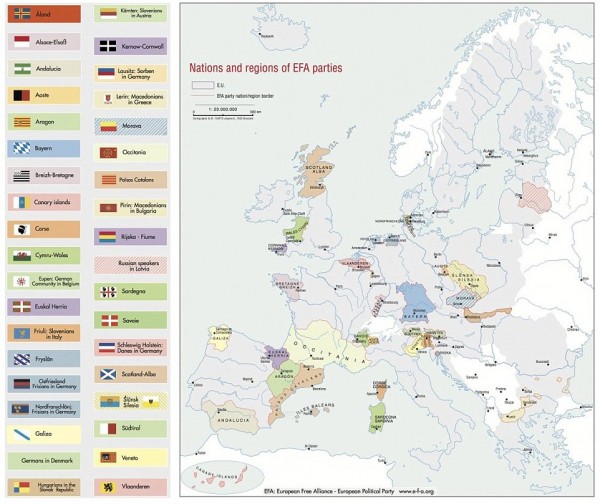Welcome To The Jumble: An Analysis Of What Europe Would Be If All Separatists Got Their Way
| David Perry | | Sep 18, 2014 08:51 AM EDT |
(Photo : www.e-f-a.org) Europe is home to no less that 37 separatist groups calling for their own nations.
Pass or fail, the referendum for the independence of Scotland is being closely monitored by like-minded separatist groups all over the world. Should the Scottish choose to secede from their 411-year union with England, it could set off a domino effect among other, long-simmering independence movements. Should it fail, it brings other those groups from nowhere to somewhere regarding their tactics.
Like Us on Facebook
A map released by the Brussels-based European Free Alliance (EFA) shows that within the borders of the 28-member European Union alone, 37 separate groups are calling for greater self-rule or independence.
While on the whole speculative — not all the calls for statehood are of equal volume — the map neatly demonstrates those nations with a vested interest in the United Kingdom staying whole.
Spain has no less than seven regions, Andalusia, the Basque Country, the Balearic Islands, the Canary Islands and Catalonia are itching for increased autonomy or outright independence.
Latvia, with its very large Russian-speaking minority, openly worries of a civil crisis similar to that of Ukraine, whose civil crisis rides on the back of its Russian population. Germany could lose all of Bavaria.
Composed of 40 progressive nationalist, regionalist and autonomist parties from across the European Union, the EFA works to make the idea of a "Europe of the Peoples" a practical reality.
"[It] focuses its activity on the promotion of the right of self-determination of peoples, human, civil and political rights, democracy, internal enlargement, multi-level governance, devolution of powers, cultural and linguistic diversity," the EFA said.
Like most regions, Europe gained its current borders through a gradual process of wars, treaties, assignments, and in some cases, the marriage of one monarch to another. In the case of Scotland, it merged into one polity with England after King James I assumed the English throne left vacant by the death of Queen Elizabeth I in 1603.
However, unification did not necessarily erase national characters. In 2007, polarization between the Flemish and Walloons plunged Belgium, existing since 1830, in a state of war where there was effectively no government for 194 days. The same happened again after the 2010 elections, and was only resolved after 540 days later.
In March of this year, a private poll found 89 percent of Venetians wanted to separate from Italy. Part of Italy since 1866, the Veneto, angry with high taxes and bureaucratic bumbling in Rome, began calling for independence a decade ago.
"'The Venetian people realized that we are a nation [worthy of] self-rule and openly oppressed," said Paolo Bernardini, professor of European history at the University of Insubria in Como.
Bernardini added it was "high time" for the Veneto to become an autonomous state again.
Not all regions on the map seek independence. While the EFA qualifies Moravia, currently a part of the Czech Republic, as restive, the community does not seek independence, only a greater role in how it is governed from Prague.
"We're not anti-Czech. We aren't chauvinists, and we aren't separatists," says Ivan Drimal, former chairman of the Moravian National Party. "We aren't trying to make Moravia an independent state."
Scotland votes on independence today.
TagsScottish independence, Europe, European Free Alliance, Scotland
©2015 Chinatopix All rights reserved. Do not reproduce without permission
EDITOR'S PICKS
-

Did the Trump administration just announce plans for a trade war with ‘hostile’ China and Russia?
-

US Senate passes Taiwan travel bill slammed by China
-

As Yan Sihong’s family grieves, here are other Chinese students who went missing abroad. Some have never been found
-

Beijing blasts Western critics who ‘smear China’ with the term sharp power
-

China Envoy Seeks to Defuse Tensions With U.S. as a Trade War Brews
-

Singapore's Deputy PM Provides Bitcoin Vote of Confidence Amid China's Blanket Bans
-

China warns investors over risks in overseas virtual currency trading
-

Chinese government most trustworthy: survey
-

Kashima Antlers On Course For Back-To-Back Titles
MOST POPULAR
LATEST NEWS
Zhou Yongkang: China's Former Security Chief Sentenced to Life in Prison

China's former Chief of the Ministry of Public Security, Zhou Yongkang, has been given a life sentence after he was found guilty of abusing his office, bribery and deliberately ... Full Article
TRENDING STORY

China Pork Prices Expected to Stabilize As The Supplies Recover

Elephone P9000 Smartphone is now on Sale on Amazon India

There's a Big Chance Cliffhangers Won't Still Be Resolved When Grey's Anatomy Season 13 Returns

Supreme Court Ruled on Samsung vs Apple Dispute for Patent Infringement

Microsoft Surface Pro 5 Rumors and Release Date: What is the Latest?










